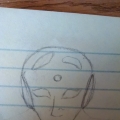Om Mani Padme Hum - A Novel Interpretation?
 Dimmesdale
Illinois Explorer
Dimmesdale
Illinois Explorer
Hello all,
Recently I formulated my own personal interpretation of this mantra (it occurred to me just this afternoon actually) and I just wonder if it jives with anyone, as it does with me since I find it so intuitive.
Om – I regard this syllable as representing the Primal Unity of Being, as existed previously to all Duality. There is nothing original here, since Om obviously symbolizes something like this in most Eastern traditions. However, moving on….
Ma – I see this syllable as the Emergence of the First Desire, (perhaps the desire for Ma-ma?). This first hankering emerges as it were organically from the original ground of Being or Om, so there is here I think a very natural progression which continues in a logical direction as we go on….
Ni – Here we have, I feel, the first Satisfaction of (a) Desire. Desire crescendos to a climax from hankering to finite-fulfillment, and there is a temporary sense of peace felt herein, akin to having your “needs” met. As we can see, this continues the progression/evolution….
Pad – There is an abruptness and suddenness to this syllable which is somewhat jarring. Before we had a very soft, cadent, almost dreamy progression, but “pad” seems to break this rhythm. I would say that herein is the introduction of pain or privation attendant upon desire and its fulfillment, which serves to “awaken” the practitioner from the dream of duality and the futile longing for fulfillment….
Me – I interpret this to mean a type of disillusionment with desire grounded in the previous syllable. So one can say that herein the practitioner heartily “renounces” or gives up on fulfilling one’s desires as he or she recognizes the sequence of events which take place in the course of time. It is interesting that “Padme” traditionally mean “Lotus” since that is itself symbolic of awakening and turning over a new leaf, and these two syllables appear to reflect the same lesson. "Meh" also is just such an indifferent sound. So "Padme" may mean something like "indifference to pain" in this sense.
Hum – This syllable I take to be symbolic of Enlightenment or spirituality in general, as it is the final logical step in the practitioner’s evolution (and this is in-keeping with other interpretations). I also see the sound as representing ineffability, “hum” resembling a mystical wind which renders all our concepts obsolete and inadequate to the Reality.
I’m very eager to find out if anyone has come across a similar or even identical interpretation to this one! It seems very natural to me and I’ve enjoyed meditating upon this mantra with this meaning and think I’ll incorporate it into my practice as time goes on.
Namaste.


Comments
Interesting interpretation @Dimmesdale
I tend to stick with the original..
The Jewel is in the Lotus AKA What we seek we 'already' are
I feel your explanation is exactly right. Most of them are:
Om is the reverse of Moo or Mu, anti-cow dharma used by zeniths
Man I is similar to I Woman, the personification of mundane being
Pad Me (I tend to use peme as it is softer padding) is the buffer zone
Hum is used by singing bees and other cool cats, dolphins and acoustic healing
... welcome to NewBuddhist
The Jewel in the Locust
I hope I didn't come across as anti-woman, that wasn't my intention...
Let me try and redeem myself by saying that desire in and of itself is not bad, that it serves a purpose and has meaning..... It's a link in the process, and Oneness' desire to make itself manifold has inherent nobility, together with space-time. At the end of history however, once desire has served its function, there will be the Light of Being simply, couched perhaps in an embroidered subtext of cosmic Meaning.....
@Dimmesdale , @lobster has the sense of humour you need to adapt to... )
I think if we take the general intention that the Mantra is grounding, benevolent, all-encompassing and Compassionate, even thinking it, resonates within our Mind and heart, and can purify us internally and project and emanate externally, for the Good of All Beings...
If it works for you, that is fine. Our mind works with our concepts.
But what it actually means (as explained to me by a Tibetan Lama) is:
"Om" refers to the state of Buddhahood. The body/speech/mind of being a Buddha.
"Mani" refers to the state of compassion.
"Padme" refers to the lotus ... it has its roots in the mud, but it grows up to surface of the water, and in the sunlight it blossoms .. so the lotus is an analogy for wisdom gained
"Hum" is the equivalent of "make it so".
So the statement basically focuses on compassion and wisdom being the route to becoming a Buddhahood, and the intention TO do so.
The mantra has worked for aspiring Buddhists for 2500 years, and I have no desire to make it different.
This seems to be an account of how you experience saying the mantra. It's good to focus on on our feelings when we do these practices. I don't think anyone would disagree. On terms of that nasty "literal" meaning, the precise meaning of one of the words is contested (by linguists) and two have no clear exact semantic meaning.
Oṁ and it's longer version, Auṁ, as well as hūm, are what is called "mantric sounds." They have no semantic meaning, in and of themselves, but what is assigned to them by a Buddha, a given exegesis in sūtra, or a Lama who has inherited a meaning for them. I have heard some Tibetan Buddhists say that Oṁ refers to universal auspiciousness, but that seems to be an assigned meaning rather than something that can be inferred through etymology, etc.
A māṇi is a treasure, particularly a jewel, AFAIK, like the wish-fulfilling gems the Buddhas often refer to in their teachings, much like the pearl of great wisdom Jesus speaks of a poor woman finding in a field, if I remember hos parable correctly.
Padme is what is contested. A padma is a red lotus. When we see the -e stem infected onto this word, padme, it can be taken to be a locative, meaning it describes a location, i.e. "in the red lotus."
But this -e transformation can also be a nominative ending in some very old Prākritic/Prākritized forms of Buddhist Sanskrit. We often see what are believed by some to be -e nominal stems in mantras. So reading the -e as a nominal state gets rid of the "in the" in the English.
So, for a literal meaning, we have three basic parsings of the mantric statement depending on how we read the māṇipadme compound with the end, as a locative or as a nominative, and depending on how we understand the compounding to be read:
Oṁ, the jewel in the lotus, hūṁ.
and
Oṁ, the jewel of the lotus, hūṁ.
and
Oṁ, the jewel, the lotus, hūṁ.
I think I prefer, based on your reading above:
Umm, money, pad me. Hmmm.
We all know the true end-goal of spiritual practice is the accumulation and celebration of material prosperity, so it only makes sense the Buddha would have us visualize ourselves padded with money.
I'm not sarcastic at all, of course. Or am I?
Yeah, I did figure lobster was engaging in satire, I was just worried that his interpretation of the "ma ni" as in "Man I" was a critique of my Ma = desire/Ma-ma, and thus a lampooning of my negative assessment of desire and pinning it to Mother.... Just phonetically I experience "ma" to be akin to desire, and then I thought of "ma." So... yeah, I didn't intend it to be anti-woman (or Man for that matter).
Hope that clears things up.
Enlightenment is genderless...
OM Mani Padme H'ng....
Or does enlightenment absorb both genders (and any others) and synthesizes them in terms of it's own being? Such that it includes all the attributes of all conceivable sexes.
When Venerable Maitreyanāthasāramati wrote his commentary on the Tathāgatha-womb scriptures, he included this parable about the Buddha's gnosis, which is gnosis of the persistent dharma, the stable dharma, the dharma fixed in it's course, the specific conditionality (Saṁyuttanikāya 12.20), which is all dharmas itself, the standing of these dharmas, the suchness of these dharmas, neither departing from the truth nor differing for the real, truth and reality without distortion (Saṁyutkāgama 296), wisdom extant regardless of the arising of a Victor (Saṁyuttanikāya 12.20, paraphrase). He quoted:
(Venerable Maitreyanātha, Uttarekayānaratnagotraśāstra ("The Treatise of the Treasure-lineage of the Utmost Body," T1611.827a16, translation mine)
All subjects are the object of the compassion of the Tathāgata, all genders, all embodiments.
Instead of a trail of incomprehensible lengthy Sanskrit words, I like to also render the titles of these Buddhist masterpieces with a sense of the English meaning.
In this instance, I misread the word.
I read uttara + kāya + ratna + gotra + śāstra,
but the reality is uttara + eka + yāna + ratna + gotra + śāstra.
The kayā vs kāya in the compound confused my eyes. The correct English title is "Treatise of the Treasure-Lineage of the Utmost and Singular Vehicle."
Thank goodness that's been cleared up....